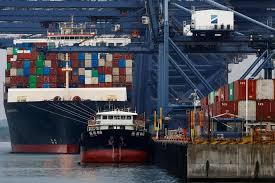
As the United States and Europe have sought to loosen their economic ties with China in recent years, Beijing has focused on expanding its export markets across the ‘Global South’, particularly in Southeast Asia.
But this could create significant economic risks as the region's manufacturers struggle to compete.
Regardless of the contours of any eventual U.S.-China trade deal, Beijing’s exports to America seem destined to continue falling, as do those to the European Union. The bloc has been seeking to “de-risk, opens new tab” from Chinese imports and supply chains, particularly when it comes to electric vehicles, batteries and solar power equipment.
China’s exports to the U.S. and the EU have already been declining steadily for years. In 2018, almost 20% of China’s exports were to the United States. By 2024, this was down to 14.7%. The proportion of exports to the EU also declined, though less dramatically, from 17.0% to 14.4% during this period.
China has actually been reducing its export dependence on all developed economies, including Japan, South Korea and Taiwan. Instead, the manufacturing powerhouse has been expanding ties with the ‘Global South’, particularly Southeast Asian nations (ASEAN).
In fact, 16.4% of China’s exports went to ASEAN in 2024. That’s more than the shares claimed by the U.S. or the EU.
WANING TRANSSHIPMENT
China’s focus on ASEAN accelerated after the 2018 trade war that started during U.S. President Donald Trump’s first term, as exports bound for America appeared to be re-routed through Southeast Asian countries.
The most notable example of this is Vietnam, whose incremental exports to the U.S. matched its incremental imports from China almost exactly in the first few years after the beginning of the previous Trump trade spat.
But China is increasingly struggling to maintain this transshipment route.
The Trump administration originally slapped staggeringly high ‘reciprocal’ tariffs on ASEAN economies on April 2, partly to hinder this export re-routing. While these tariffs have since been delayed, several Southeast Asian governments have begun to crack down, opens new tab on violations of “country of origin” rules by their exporters to defend their reputations as responsible trade partners.
And even though Chinese exports to ASEAN economies are currently mostly intermediate goods that are re-processed and exported, that is starting to change as more finished goods are ending up in Asia’s domestic markets.
CAVEAT EMPTOR
These ASEAN imports of low-priced finished goods from China, many sold through e-commerce platforms, have already become a bugbear for local manufacturers, particularly in Indonesia and Thailand.
In Indonesia, as imports of Chinese clothing have risen in recent years, the country’s own textile sector has laid off workers, including 80,000 in 2024, with 280,000 more, opens new tab estimated to be at risk in 2025.
In Thailand, more than 100 factories, mostly small and medium-sized enterprises, closed down every month from 2021 to 2024. According to independent think tank K- Research, opens new tab, these factories were mostly manufacturing furniture, electronics, garments, automotive and steel – all industries that have faced competition from inexpensive Chinese goods in recent years.
Source: Reuters
Share: